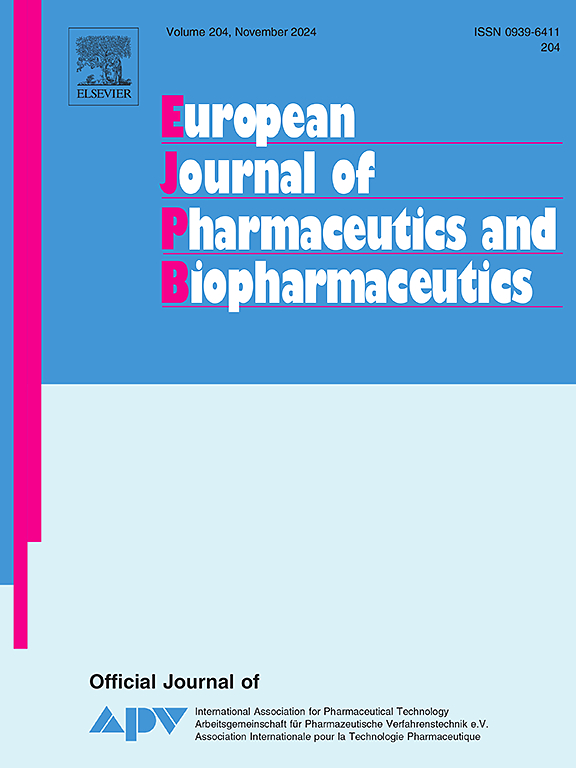Small milk-derived extracellular vesicles: Suitable vehicles for oral drug delivery?
IF 4.3
2区 医学
Q1 PHARMACOLOGY & PHARMACY
European Journal of Pharmaceutics and Biopharmaceutics
Pub Date : 2025-05-10
DOI:10.1016/j.ejpb.2025.114744
引用次数: 0
Abstract
Current treatments for inflammatory bowel disease often fail due to systemic side effects, but bovine milk-derived extracellular vesicles (EVs) show promise for targeted delivery to inflamed gut tissue via the leaky gut effect. This study assessed the stability of EVs as drug carriers in simulated gastrointestinal (GI) fluids and their efficacy in a colitis mouse model. EVs were characterised after incubation in PBS at various pH levels, and their lipid bilayer stability in biorelevant GI fluids was evaluated using the polar probe laurdan. Two small molecules, acridine orange (lipophilic) and riboflavin (hydrophilic), were loaded into EVs to test their release under GI conditions, while unloaded EVs were investigated for therapeutic effect via oral gavage or rectal enema in a colitis mouse model. Although no significant changes in EVs’ physical properties were observed at different pH levels, lipid bilayer damage was evident in acidic (p ≤ 0.05) and enzyme-rich environments (p ≤ 0.01). Acridine orange release was significant (p ≤ 0.05), but riboflavin remained encapsulated, and no therapeutic effect was observed with unloaded EVs in vivo. These results suggest that physical characterisation alone does not reflect EV stability, that bovine milk EVs have limited potential for oral drug delivery and are better suited for hydrophilic drugs.

乳源性细胞外小泡:口服给药的合适载体?
目前对炎症性肠病的治疗往往由于全身副作用而失败,但牛奶来源的细胞外囊泡(ev)显示出通过漏肠效应靶向递送到炎症肠道组织的希望。本研究评估了ev作为药物载体在模拟胃肠道(GI)液体中的稳定性及其在结肠炎小鼠模型中的功效。在不同pH水平的PBS中孵育后,对电动汽车进行了表征,并使用极性探针laurdan评估了它们在生物相关胃肠道液体中的脂质双分子层稳定性。将两种小分子吖啶橙(亲脂)和核黄素(亲水)装载到ev中,测试其在胃肠道条件下的释放情况,同时通过结肠炎小鼠模型口服灌胃或直肠灌肠研究未装载ev的治疗效果。在不同pH水平下,电动汽车的物理性能无显著变化,但在酸性环境(p≤0.05)和富酶环境(p≤0.01)中,脂质双分子层损伤明显。吖啶橙释放量显著(p≤0.05),但核黄素仍被包裹,体外未见治疗效果。这些结果表明,单独的物理特性并不能反映EV的稳定性,牛奶EV的口服给药潜力有限,更适合于亲水药物。
本文章由计算机程序翻译,如有差异,请以英文原文为准。
求助全文
约1分钟内获得全文
求助全文
来源期刊
CiteScore
8.80
自引率
4.10%
发文量
211
审稿时长
36 days
期刊介绍:
The European Journal of Pharmaceutics and Biopharmaceutics provides a medium for the publication of novel, innovative and hypothesis-driven research from the areas of Pharmaceutics and Biopharmaceutics.
Topics covered include for example:
Design and development of drug delivery systems for pharmaceuticals and biopharmaceuticals (small molecules, proteins, nucleic acids)
Aspects of manufacturing process design
Biomedical aspects of drug product design
Strategies and formulations for controlled drug transport across biological barriers
Physicochemical aspects of drug product development
Novel excipients for drug product design
Drug delivery and controlled release systems for systemic and local applications
Nanomaterials for therapeutic and diagnostic purposes
Advanced therapy medicinal products
Medical devices supporting a distinct pharmacological effect.

 求助内容:
求助内容: 应助结果提醒方式:
应助结果提醒方式:


